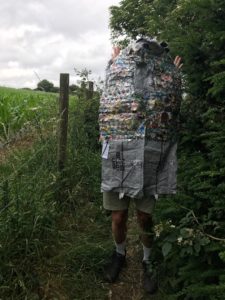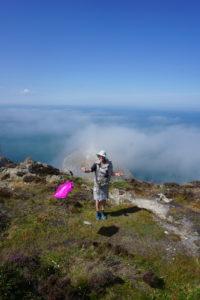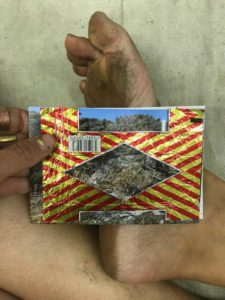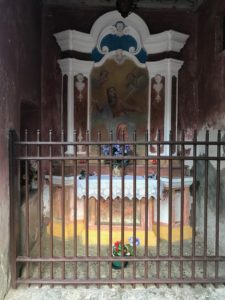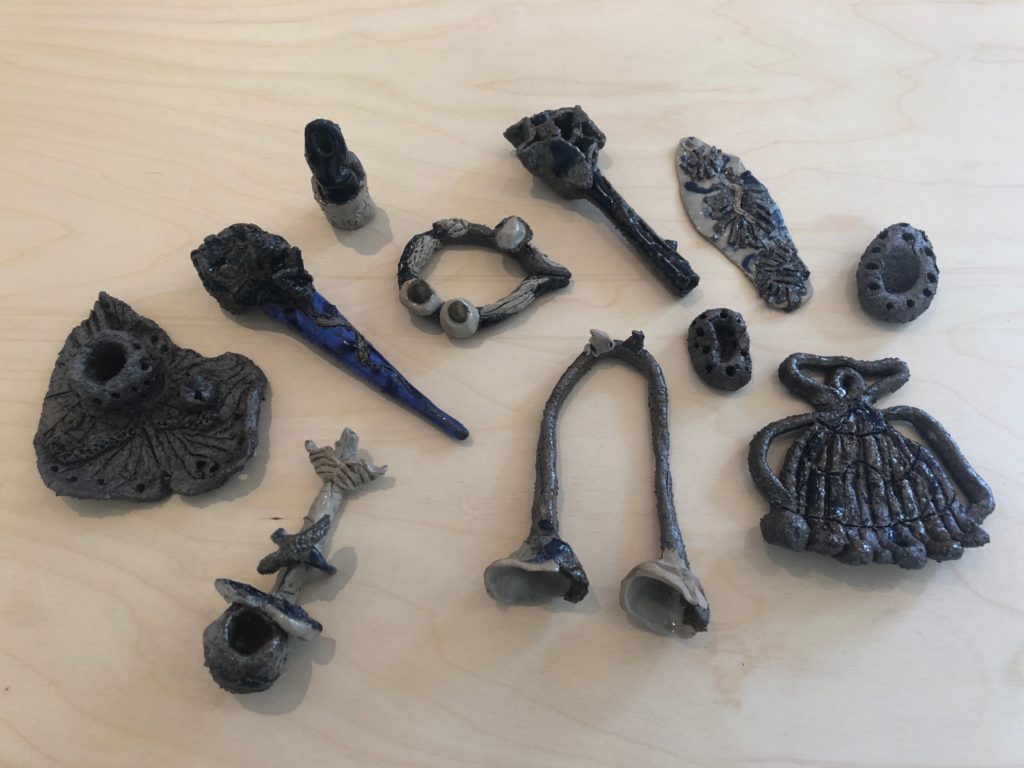ongoing // floral pilgrimageOver the last three years I have been creating costumes designed for everyday living or survival in London. These have mainly taken the form of newspaper costumes, including an outfit made from icons from an app designed to help you save money, a floppy paper suit of British armour and tassels developed for attachment to a cloak or shield designed to both represent and ward off fears concerning Brexit. These can be seen under newspaper city props and marlon brando island videos. “Heraldry is a study which loads the memory without improving the understanding.” Herald Peter Le Neve, 1696 (From Ann Payne, Medieval Heraldry.) My latest costume is an evolving pilgrimage suit that I started work on in Summer 2017 in connection with a series of workshops and commission Floral Heraldry for a cabinet space at PEER Gallery. Milk tops from a collection of mine from Switzerland (where I used to live and perform as “The THERE-THERE School of English Dada”) have been insulated with tape and pinned onto a British mail sack. The Milk Tops fascinate me as elements of ‘home’ culture and national identity are highlighted: alpine festivals, Swiss wrestling, Albert Anker children, alongside more exotic themes of tropical fish, or beautiful ever stereotypical holiday destinations in abroad. An atrophied absurdity and rupture; these mini milks would have been consumed in a moment perhaps unnoticed, possibly far away from the symbolism of the image, creates an adjunct that interests me and this costume aims to extend from the UK. I built a suit of these images connected to pictures I felt were both protective and reflective of my character, including many flowers as a chainmail of everyday events and sights which I could then add to, cutting out extra meaning to be left with flippant politics of packaging. My first walk was in 2017 with my father from Gravesend to Canterbury along sections of the Pilgrim’s Way. I was interested in observing the landscape of British flowers from the perspective of a floral artist, recording the seasonal differences and commonalities between flowers available at the market and grown in the fields loosely on the London to Holland flower-route. Using images from the walk I hand cut my own milk tops attaching them into the costume to replace damaged or worn patches with British seasonal flowers and sights. Between 2017- 2018 I started a collaboration together with artist and educator Amy Ash, this time contemplating both physical and political changes to the landscape. We were drawn to walking around Holyhead, an island protruding off Wales, in alternative directions retracing the steps of St. Cybi and St. Seriol. One Saint who faced the darkness, the other the light which felt like a dualistic coping metaphor for the political horizon. This follows a period of dark reflection as Amy although married to a Londoner was nevertheless coerced into leaving London due to visa issues and so I walked in her place during Summer 2018, exploring sites of importance as either St. On this walk for each holy spot (assessed by both site and feeling) I would document both the landscape and myself in it, to create a more embodied response of the situation on the Island as something transferable to her. Then using snack bar wrappers, local pamphlets and these images, I sent her a map-place of the Island, something to both peruse and wear / physically enter. In Ireland after leaving Anglesey, I then visited the outer most promenentray where rough tar lined boats would have sailed to the Americas. Together with my former colleague Alice Benetti who moved to Ireland, Dingle last year to grow flowers we created a tribute to St. of the Bees. We then traced the blessing with the same line of the necklace down to the waterfront to connect with Amy. Later in the Summer I visited Ameno, Northern Italy on invitation of my friend St. Pauli who runs DADA Paradiso and with whom I used to perform at his Soiree Surprise at Cabaret Voltaire. It took twenty five days to walk there and en route I collected samples of weeds, photographs of wildflowers and small cuttings of foliage encountered from the roadside. As I entered the small village the landscape seemed to become increasingly moist green and lush, and I began to notice spiral symbols chalked onto buildings. The only condition of the residency is that you have to perform, so I chose to combine the spiral – symbol of pataphysics – and cuttings, attempting to use them as a form of direct news from the landscape by rolling them in ink, pressing them into cone like bouquets of tabloid shaped paper before reading them with the public at the local wash basins. 2019 – After my biggest ever commercial job as a floral artist in 2019, creating seven large hanging installations and complimentary tablecentrepieces within an arena, it felt like time to turn an eye to the flower industry… Part in awe of being able to work with flowers from across the world in February but also to better consider how they were transported / grown and what the commercial / economical implications of these movements are… And it was eye opening! I travelled together with fellow florist, Liz and pal Carol. We coursed the flower route travelling down from Haarlem to Leiden, looking at the tulip fields, before moving inwards towards the Royal Flower Market and glasshouse Venice: Naaldwijk. The biggest shocks for me were the level of visible wastage between the glass lit passages (highest light pollution in world here) and price of flowers at the market. The market is like a disco: people and flowers zipping around to pop music. Big canteen beckons if you’re in a fluorescent vest. Inside one of the two auction rooms, flowers and flashing circles whizz into action and it’s impossible to follow. The next step on the route was a residency organised by Wim Wauman bringing together a selection of artists whose practices all contained or operate close to crafts. As the floral pilgrim, I was bringing technical skills with flowers to the new community Blauwhaus, loosely based on Bauhaus and William Morris’ Red House. There I gave a floral workshop to local arts Academie in Waasmunster: making micro bouquets in ice cream cones, and made a series of clay pipes and start of a well dressing for table which was a collaborative project with Veerle Verschooren and Cardon Lander. All these works will then be installed by the artists collectively for final performance parade on May 26th. Whilst in Belgium I also hoped to have time to visit Epen and continue ongoing work Zinc Violets with friend Sarah Boulton which started in Masons Yard Gallery last year but the journey proved too complicated: an exhibition happening in the space of an evening, comprising of two intangible artworks. One is a prediction and the other, a scent. Both have occurred and will be occurring. Extract from Press release, Masons Yard UPCOMING // Cultivar Project 29.06.19 – 16.07.19 // Museum of The Flat Earth, Fogo Island Having missed the opportunity to work and walk with Amy Ash last year in 2018, due to hostile environment of UK, we secured a residency together on Fogo Island. We propose to travel to Fogo Island (an area in between the coasts we both currently look out from) to research by walking, collecting thoughts and local plant-life. Drawing from our physical exploration of the Islands flora and the metaphorical implications of botanical terminology, we will explore botanical and cultural hybridization to connect political displacement, communities and nature using Amy’s experience of a hostile environment with new possibilities for future growth as a starting point. We will imagine that beneath the surface, the islands are still connected by ever-evolving and complex systems of rhizomes, while above sea-level the migrations (of both people and perspectives) act as an invisible adventitious root-system. We will also be working from Gilles Deleuze and Felix Guattaris concept of rhizomes for which hybridization and the multiplicity of idea exchange possibilities involving connection and disruption of binary (more root like dualistic) choices is key. In this neutral space of the Island and offered residency / sanctuary, dressed in our suits of self-preservation, we will observe and collect local flora and debris. Used in combination with plant-life and debris collected from other coastlines, we will create a mutated set of botanical possibilities — ways in which plants may have evolved in a more connected world — by grafting together new species and categorising them. From these hybrids we would then propose taking further cuttings from them: in a visual or conceptual sense, to create a series of cultivars: attempts to create a resilience new species version to suit a new environment. In addition to our collection of mutated species whose Frankenstein qualities encourage disruption of systems of understanding whilst offering new connecting points, we hope to create other temporal installations which function to uphold the same aims.
|














